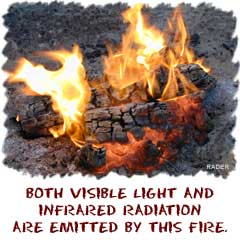Energy around Us
 An old song says, "Love makes the world go 'round." They were wrong. Energy makes it all happen.
An old song says, "Love makes the world go 'round." They were wrong. Energy makes it all happen.
The energy that cycles through the systems of Earth comes from two locations. The Sun radiates huge amounts of energy. Only a small portion of that energy hits the Earth, but it is enough to light our days, heat our air and land, and create weather systems over the oceans. Most of the energy you will learn about comes from the Sun.
The Earth also gives off energy. There is a molten outer core of iron (Fe) and nickel (Ni) that radiates heat and creates a magnetic field that surrounds the planet. Current evidence suggests that the inner core is 6,000 degrees Celsius (10,800 degrees Fahrenheit). The asthenosphere and upper mantle also radiate heat from the interior of the planet. Even without the heat of the Sun, the Earth would be warmer than space or a planet with no molten core.
Unless you live on a volcano or a hydrothermal region, the Sun’s energy will affect your life more than any energy from inside the planet.
Where Do You Find Energy?
 You can find energy in electricity, magnetism, kinetic energy, potential energy, springs and different states of matter. Energy is not something you can hold or touch. Energy exists as a property of matter and can be found in many places ranging from the heat from Earth’s core to incoming radiation from the Sun.
You can find energy in electricity, magnetism, kinetic energy, potential energy, springs and different states of matter. Energy is not something you can hold or touch. Energy exists as a property of matter and can be found in many places ranging from the heat from Earth’s core to incoming radiation from the Sun.
Geographers look at general ideas of energy circulating through systems. The main energy for geographers affects the living organisms of Earth. They examine amounts and types of electromagnetic radiation that include infrared (heat), visible, and ultraviolet light.
Energy descriptions and measurements change a little when physicists start looking at the world. Energy is a property that can be transferred and changed, but never created or destroyed. Physicists often see things in very specific quantities, not always in systems as large as the Earth. They also look at mechanical energy in addition to thermodynamics and electromagnetism.
Let’s say that the Sun heats the Earth and the gases of the atmosphere. As the temperature rises, the molecules become more active and begin to rise. The activity of the molecules also increases the pressure. When the pressure of a system increases, the amount of stored energy also increases. Those molecules want to move to a location with a lower pressure. Wind is created by those pressure differences in the atmosphere. When the wind blows, the energy can be transferred to other systems: turn windmills, help birds fly, make tornadoes, all types of work.
Radiation Isn't Always Dangerous
There's an important idea you should always remember when we talk about energy. Sometimes we will use the word radiation. When you think of radiation you probably think about nuclear power plants, bombs, and X-rays. Those are all types of radiation but more important to physical geography is the idea that all light is considered radiation. Electromagnetic radiation includes everything from television and radio waves to something called gamma rays.Think about the acronym LASER. The R stands for radiation; however, a laser is bascially an energized flashlight.
Think about heat. Most heat or "emitted thermal radiation" of an object is actually infrared light.
Or search the sites for a specific topic.
- Overview
- EM Spectrum
- Quanta
- Waves
- Solar Radiation
- Emittance
- Balance
- Global Geometry
- Movement
- Interaction
- Transmission
- Temperature
- More Topics

Taking Earth’s Temperature (NASA/GSFC Video)

Useful Reference Materials
Encyclopedia.com (Energy Budget):http://www.encyclopedia.com/topic/Energy_budget_(Physics).aspx
Wikipedia (Energy):
http://en.wikipedia.org/wiki/Energy
Wikipedia (Earth's Energy Budget):
http://en.wikipedia.org/wiki/Earth%27s_energy_budget
Encyclopædia Britannica (Solar Energy):
http://www.britannica.com/EBchecked/topic/552905/solar-energy





